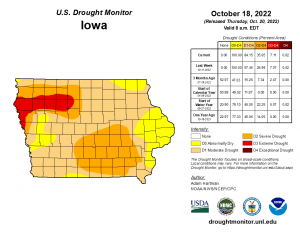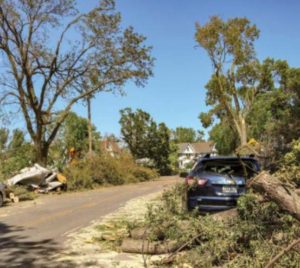
DES MOINES, Iowa — The drought conditions are continuing to worsen across Iowa. According to the latest report from the Iowa Drought Monitor released Thursday, for the period ending Oct. 18th, the entire state remains in a drought, but 84% is now moderately dry. That number was just 57% last week. About 7% of the state remains extremely dry.
Today: Sunny, with a high near 77. Southwest wind 5 to 8 mph.
Tonight: Mostly clear, with a low around 45. Calm wind becoming south 5 to 7 mph after midnight.
Tomorrow: Sunny, with a high near 79. Breezy, with a south wind 8 to 17 mph, with gusts as high as 24 mph.
Sunday: Mostly sunny, with a high near 82. Windy.
Sunday Night: A chance of showers and thunderstorms. Partly cloudy, with a low around 54. Windy. Chance of precipitation is 40%.
Monday: A 50 percent chance of showers. Mostly cloudy, with a high near 65. Breezy.
Thursday’s High in Atlantic was 69. Our Low was 25. Last year on this date the High in Atlantic was 49 and the Low was 28. The Record High on this date was 87 in 1947. The Record Low was 13 in 1930.
(Radio Iowa) – Recent events like Hurricane Ian hitting the southeastern U-S and the derechos in the Midwest have prompted some to ask if it’s better to bury power and communication lines underground versus hanging them above ground on utility poles. Rod Pritchard, a spokesman for I-T-C Midwest, says it really comes down to dollars. “The cost of that is a main determining factor,” Pritchard says. “Compared with overhead line construction, the cost of underground transmission is five to ten times more, and so we view it as being cost prohibitive.”
Pritchard says environmental factors are also a consideration, as putting cables underground disturbs a lot of soil. “Although the underground line is much better protected in terms of storm events, when you do have an outage with underground line, it can take a lot of work to find that as well as to fix that problem,” he says, “whereas overhead lines are much easier to repair if there is an outage.”

Cedar Rapids post-derecho in August of 2020 (Trees Forever photo)
I-T-C owns and operates high-voltage transmission infrastructure in Iowa and six other states, with its ITC Midwest subsidiary based out of Cedar Rapids. Across its system, I-T-C has 16-thousand circuit miles of transmission line.
Today: Partly cloudy. High 66. W/SW @ 10-20 mph.
Tonight: Partly cloudy. Low 43. SW @ 5-10.
Tomorrow: P/Cldy. High 75. SW @ 10-20.
Saturday: P/Cldy. High 78.
Sunday: P/Cldy. High near 80.
Wednesday’s High in Atlantic was 55. Our Low was 12 (that tied the old, 24-hour Low of 12 set in Oct. 19, 1972). Last year on this date the High in Atlantic was 64 and the Low was 41. The Record High on this date was 87 in 1947 & 2003. The Record Low for Oct. 20th, was 14 in 1960.
Today: Mostly sunny. High 51. W @ 10 mph.
Tonight: Fair to partly cloudy. Low 30. SW @ 5.
Tomorrow: P/Cldy. High 64. W/SW @ 10-20.
Friday: P/Cldy. High 73.
Saturday: P/Cldy. High 75.
Tuesday’s High in Atlantic was 43. Our Low this morning, 13 (that beats the old, 24-hour Low of 17 set in 1952). Last year on this date the High in Atlantic was 76 and the Low was 52. The Record High on this date was 88 in 2003. The Record Low was 12 in 1972.
(Radio Iowa)/KJAN) – It’ll be one of those weeks in Iowa where our attire may include both winter coats and shorts. This (Tuesday) morning, some communities experienced lows in the low 20s and wind chills below zero. Meteorologist Ashley Bury, at the National Weather Service in Johnston, says four Iowa cities had record low temperatures early today. “We had 21 degrees at the Des Moines airport, which beat 22 degrees that we had in 1972,” Bury says. “At Lamoni, it was also 22 and Ottumwa was 22, which beat the records in 1972 when their lows were also 23. So just a degree lower for those three sites, but that did break our record today.”
In Atlantic, the 24-hour Low ending at 7-a.m. was not a record breaker, but after 7-a.m., we dropped to 16 degrees, and that broke the old record for Oct. 18th, which was 17 degrees, set in 1952. The forecast is calling for an overnight Low of around 15, so the record Low statistic may change again. Webster City broke a 70-year-old record this morning with 16 degrees, besting a record of 18 set on this date in 1952. If we can endure a little more cold, Bury says warmer weather is coming. “Another chilly night tonight, mainly in the low 20s again, maybe some upper teens, no records look like they’re going to be broken though,” she says, “but after that, we’re going to see some highs back in the 50s and even by the end of the week, Friday into the weekend, we’re going to see temperatures even in the 70s, so it’s gonna be nice and warm for October.”
While today’s highs are mostly in the low 40s, highs by Saturday may be near 80.
(Radio Iowa) – Harvest season is underway in Iowa with drought conditions ranging from severe to extreme — and forecasts show those conditions will likely continue well into winter. Meteorologist Dennis Todey, director of the U-S-D-A’s Midwest Climate Hub in Ames, says there are a few benefits to the dry weather, like how the tractors aren’t getting mired in mud. “People, when they’re ready to harvest, are going to be able to get out and harvest because there’s nothing really slowing them down,” Todey says, “though the thing that may slow them down in some cases is that beans may be too dry or something like that. I was hearing people waiting until the evening when it’s a little more humid to do some harvesting.” Todey says the soil continues to dry out and dry deeper across wide sections of Iowa.
“Soils are very dry at this point,” he says, “so soil moisture recharge is a concern and a very serious concern because of some dryness expanding all the way back into 2021 that we didn’t quite recover from completely.” Todey says there are a number of harvest time hazards for farmers and passing motorists due to the dry conditions. “I was driving through southern Minnesota last night and somebody was doing a bean field that looked like there was a fog over the bean field because there was so much dust kicked up,” he say. “I saw somebody tweet, too, that it was a good thing that they had auto-steer because I’m not sure they could see where they were going because of the dust that’s being kicked up. So, multitude of problems because of very severe drought.”
Many locations in Iowa are now showing six-to-eight-inch precipitation deficits for the year.
Today: Mostly sunny. High 44. N/NW winds @ 15-25 mph.
Tonight: Mostly clear. Low 15.
Tomorrow: Mostly sunny. High 52. W @ 10-15.
Thursday: Partly cloudy. High 62.
Friday: P/Cldy. High near 72.
Monday’s High in Atlantic was 46. Our Low this morning, 16. Last year on this date the High in Atlantic was 75 and the Low was 38. The Record High on this date was 86 in 2003. The Record Low was 17 in 1952.
AMES, Iowa – Oct. 17, 2022 – There’s an unmistakable chill in the air as fall slowly creeps into winter. Keeping roads in their best shape to ensure you get where you want to go, no matter the season is the goal of employees with the Iowa Department of Transportation. As the weather changes, their focus is keeping the roads as clear as possible and giving you the information you need to make smarter, safer travel decisions.
What you can do to prepare for the months ahead:
Winterize your vehicle – To minimize the possibility of a breakdown, get your vehicle tuned up. Check your vehicle’s wipers, hoses, battery, alternator, belts, tires, brakes, exhaust system, lights, and fluid levels. Make sure your vehicle’s heater and defroster are in good working order and you travel with plenty of gas in your tank. A breakdown is frustrating on a good day but can be dangerous during wintry weather.
Place a winter survival kit in your vehicle – This kit should contain items to help sustain your life and the lives of your passengers should your vehicle become stranded during inclement weather. These items can include booster cables; a flashlight with fresh batteries; extra blankets and warm clothes; nonperishable, high-calorie food items; candles, matches, a can for melting snow for drinking water, and a snow shovel. Sufficient supplies should be in the kit for all persons traveling in the vehicle. Carrying a mobile phone and charger in your vehicle is also advised for use during an emergency.

DOT Snow plow cam on I-80 near Atlantic. (FILE PHOTO)
Use technology to help make better travel decisions – The winter road conditions layer is now visible on www.511ia.org. This layer, along with layers that show images directly from the windshields of our snowplows and stationary cameras along the roadside, can help you determine whether it is safe to travel now or if you should postpone your trip.
Kick your winter driving skills into gear – The first snowfall and slick roads are a quick reminder that it’s time to re-evaluate and adjust your driving behaviors.
How the Iowa DOT has prepared:
Our people and equipment – The department’s 101 maintenance garages employ 1,083 full-time equipment operators, mechanics, and supervisors, and are in the process of hiring up to 633 temporary employees this winter season, to keep the agency’s 902 trucks, 42 motor graders, 32 tow plows, and 10 heavy-duty, self-propelled snowblowers on the road during winter weather.
For those interested in temporary, part-time snowfighter positions, go to https://iowadot.gov/careers and click on the “seasonal/temp” tab.
The materials we use – The Iowa DOT has spent the warmer months stocking salt in our storage facilities for use during the winter. Buying during the spring and summer allows us to obtain better pricing because demand is low. On average, the Iowa DOT uses more than 144,00 tons of salt and nearly 33 million gallons of brine each year to help maintain safe travel on the primary highway system, consisting of interstate, U.S., and Iowa routes.
The Iowa DOT primarily uses salt brine, a simple solution of standard rock salt and water, to help with winter roadway maintenance. It can be used to pretreat roadways before a storm, thus preventing snow and ice from bonding to the pavement. Brine is also used to prewet salt before it leaves the truck, increasing its ability to melt snow and ice and helping keep it on the roadway surface.
You may wonder why Iowa DOT trucks sometimes spray brine on sunny days. Frost is a major safety factor this time of year. The Iowa DOT’s proactive approach of spraying brine on areas prone to frost prevents the formation of an icy layer, which typically occurs on cold, clear nights. Frost is hard to see on the road’s surface and most people don’t expect it. These unexpected encounters with a frost-covered bridge or roadway can be particularly treacherous when traveling at higher rates of speed, making it more difficult to maintain control of your vehicle.
For more information about winter preparedness and the Iowa DOT’s snow and ice control program, check the Iowa DOT’s winter safety website.
Today: Partly cloudy. High 46. N/NW winds @ 15-25 mph.
Tonight: Mostly clear. Low 18. N @ 5-10.
Tomorrow: Mostly sunny. High 44. N @ 10-15.
Wednesday: Mo. sunny. High 52.
Thursday: P/Cldy. High 62.
Sunday’s High in Atlantic was 58. Our Low this morning, 27. Last year on this date the High in Atlantic was 73 and the Low was 33. The Record High on this date was 87 in 1947 & 2016. The Record Low was 12 in 1976.